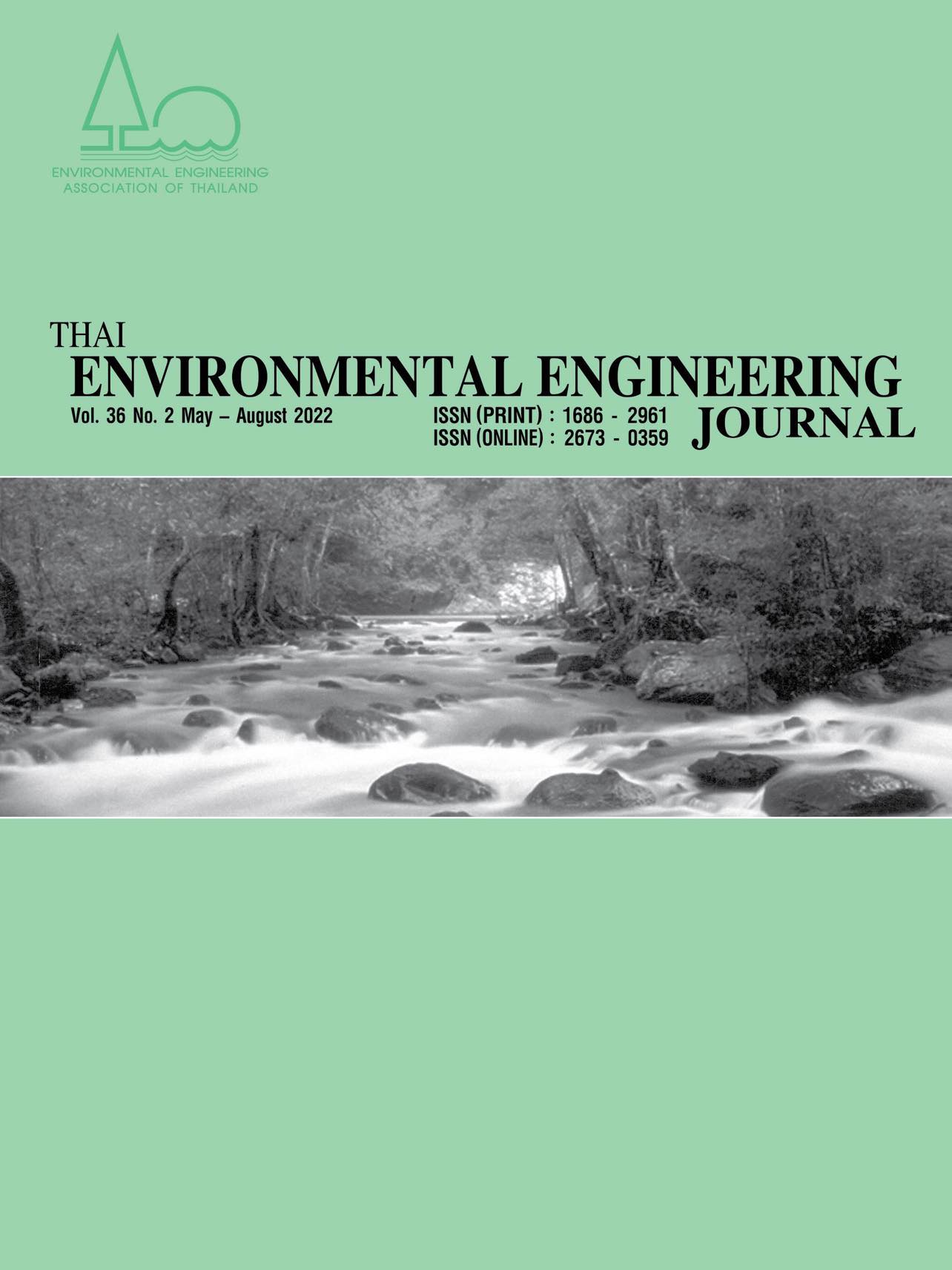COD Removal Efficiency of Pararubber Wastewater by Ozonation using the Central Composite Design Model
Main Article Content
Abstract
Pararubber is one of the major plants contributing to both Thai and Asian’s economy. Pararubber wastewater having a high strength can cause several environmental problems to community nearby the industry. The research aimed to study the characteristics of pararubber wastewater and investigate the optimal conditions for treatment of pararubber wastewater using the ozonation process. The results revealed that the pararubber wastewater has a black color with a pungent odor like sludge from a septic tank. Wastewater characteristics obtained from the preliminary analysis are as follows; pH of 4.99, Chemical Oxygen Demand (COD) of 55,448.52 mg/L, Total Dissolved Solid (TDS) of 10,240 mg/L, and SS of 1,516.67 mg/L. Factors affecting the ozonation process studied are dosage rate of ozone and contact time. The Central Composite Design (CCD) model or box-wilson design, which is an experimental design at 3 levels (popularly represented by symbols -1, 0, +1) and useful in response surface methodology (RSM) for generating a second order (quadratic) model for the response variables, was applied to investigate the optimal condition for the treatment process. From the results, it was found that both of factors significantly affected the COD removal efficiency and can be expressed in the form of equations or a mathematical model for predicting COD removal efficiency, in which %COD R.E. = 13.3408 + 0.0613A + 0.5587B + 0.000619A*B - 0.000063A2 - 0.004270B2. The coefficient of determination was 92.14%. The mathematic model was applied to develop the graph displaying the relationship between these two factors and COD removal efficiency using the Responsive Surface Methodology. It was found that the removal efficiency of COD was increased with increasing contact time and dosage rate of ozone, which has a maximum value of 89.67% at ozone dosage rate of 900 mg/hr and contact time of 120 minutes.
Article Details
References
Dechapanya, W., Taweewut, K., Mungkornkaew, P. and Lakawipat, T. 2019. Treatment of Pararubber Wastewater Using Fenton Processes. UBU Engineering Journal. 12(2): 63-76.
Anotai, J., Tontisirin, P. and Churod, P. 2007. Integrated Treatment Scheme for Rubber Thread Wastewater: Sulphide Precipitation and Biological Processes. Hazard Material. 14: 1-7.
Mohammadi, M., Man, H.C., Hassan, M.A. and Phang Lai Yee, P.L. 2010. Treatment of Wastewater from Rubber Industry in Malaysia. African Journal of Biotechnology. 9(38): 6233-6243.
Vijayaraghavan, K., Yazid, A.Y.A. and Ahmad, D. 2008. Electrolytic Treatment of Latex Wastewater. Desalination. 219(1-3): 214-221.
Srisuwan, N. 1996. Rubber Gloves Plant Wastewater Treatment by Floatation. Master of Science Thesis in Environmental Management. Prince of Songkla University.
Tuprakay, S.R. and Tuprakay, S. 2015. Wastewater Treatment from Rubber Processing by Using Solar Distillation System. SDU Research Journal. 8(2): 35-52.
Wongkamchao, Y. and Dechapanya, W. 2020. Optimization of Pararubber Wastewater Treatment using Fenton Process by Central Composite Design. Collection of articles in National Academic Conferences Ubon Ratchathani University. 226-235.
Dechapanya, W., Nontula, S., Phudthabun, S., Sanongraj, S. and Mattaraj, S. 2022. Treatment of Gaseous Formaldehyde in a Gross Anatomy Laboratory Using Ozonation. Ladkrabang Engineering Journal. 39(1): 11-22.
Maneesai, O. and Srisattayakul, P. 2014. A study the Optimization of Molybdenum Carbide Coating by Sputtering. Rajamangala University of Technology Krungthep.
Bhattacharya, S. A. 2021. Central Composite Design for Response Surface Methodology and Its Application in Pharmacy. In book: Response Surface Methodology in Engineering Science. IntechOpen. 1-19. DOI: 10.5772/intechopen.
Tansomros, P. and Wichitpanya, S. 2021. Optimal Condition for the Removal of Copper (II) using Dowex-m4195 Chelating Resin. Senior Project in Environmental Engineering Program. Mahasarakham University.
Rice, E.W. Bridgewater, L., American Public Health Association, American Water Works Association, and Water Environment Federation. 2012. Standard Method for the Examination of Water and Wastewater. Ed.22. Washington D.C.: American Public Health Association. 50-51.
Chanpirak, A., Dumnin, P. and Hongpuay, A. 2018. Optimization of Oil Extraction from Spent Coffee Grounds (Coffea canephora var. robusta/Coffea Arabica) by Hexane Using Response Surface Methodology. The Journal of KMUTNB. 28(4): 799-811.
Limratchapong, T. and Huayluek, N. 2019. Design of Experiment for Evaluating the Optimal Condition in Coffee Beans Roasting. Senior Project in Management and Logistics Engineering, College of Innovative Technology and Engineering, Dhurakij Pundit University.
Announcement of the Ministry of Science Technology and the Environment. 1996. Determination of Standards for Controlling Wastewater Discharge from Sources of Industrial Factories and Industrial Estates.
Montogomery, D.C. 2001. Design and analysis of experiments. New York: John Wiley & Sons Inc. 427-510.
Suwannahong, K., Wongcharee, S., Kreanuarte, J. and Kreetachat, T. 2021. Pre-treatment of Acetic Acid from Food Processing Wastewater Using Response Surface Methodology via Fenton Oxidation Process for Sustainable Water Reuse. Journal of Sustainable Development of Energy, Water and Environment Systems. 9(4). DOI: https://doi.org/10.13044/j.sdewes.d8.0363.


